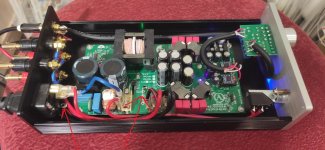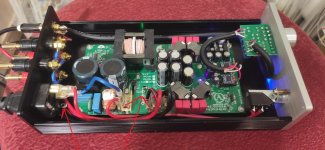In Russia it is pointless, not in the socket AC220 3 contacts, only 2 - Line and Neutral
Thank you Dr Mordor.
That explains why it wasn't connected. Most countries in Europe have a 3-pin socket that includes the earth cable.
And nerone, being in Italy, will need that chassis connection for safety.
I'm not very practical, most of my hi-fi electronics have 2 poles so they are double insulated.
Does my future drMordor amplifier need to be modified before I do any damage?
Thank you
If you were buying an amplifier like this from Europe the supplier would be duty bound to supply it earthed. You will not damage anything by it not being earthed but you have bypassed one of the key safety measures we have in place (domestically).
Mamocel is correct that up to date electrical systems have RCDs but not all are. There is still risk.
I wouldn't take that risk - bond earth to chassis and ground and ensure continuity with all metal panels within the enclosure.
Mamocel is correct that up to date electrical systems have RCDs but not all are. There is still risk.
I wouldn't take that risk - bond earth to chassis and ground and ensure continuity with all metal panels within the enclosure.
Thanks for the answers, i just connect a cable to the ends of the points indicated with the red arrow by drMordor, right?
Attachments
Last edited:
Especially not on the card .... But on the chassis of the amplifier.
Risk of earth loop.
Risk of earth loop.
Last edited:
Yes, on the board connector. This point is your ground.
Connect the earth to chassis with the bolts that secure the socket. You will need to scratch away some paint. With a multimeter check all metal panels show continuity - you may need to sand some paint away where the panels butt up to each other to achieve this.
Signal ground must go to chassis for shielding.
Ps. I think you should do your own research or have someone competent do it rather than take strangers instructions if you are unsure.
Connect the earth to chassis with the bolts that secure the socket. You will need to scratch away some paint. With a multimeter check all metal panels show continuity - you may need to sand some paint away where the panels butt up to each other to achieve this.
Signal ground must go to chassis for shielding.
Ps. I think you should do your own research or have someone competent do it rather than take strangers instructions if you are unsure.
Last edited:
Yes, on the board connector. This point is your ground.
Connect the earth to chassis with the bolts that secure the socket. You will need to scratch away some paint. With a multimeter check all metal panels show continuity - you may need to sand some paint away where the panels butt up to each other to achieve this.
Signal ground must go to chassis for shielding.
Ps. I think you should do your own research or have someone competent do it rather than take strangers instructions if you are unsure.
I bought it already assembled to avoid problems, unfortunately the latter are always there 🙂
This does not mean that the device is properly grounded. Check for safety.I bought it already assembled to avoid problems..

Buy plastic boxes, otherwise you have to make sure that the house's earth connector is less than 100 ohms:inclinaison:
i'm sorry.
do not worry, when it arrives I will ask you for help on how to proceed with grounding, the multimeter I have it 🙂
Buy plastic boxes, otherwise you have to make sure that the house's earth connector is less than 100 ohms:inclinaison:
don't scare me I'm pretty pessimistic 🙂
No NEURONE worries, no stress ...
Only,you do connect the green yellow wire to the chassis of your amp !
Only,you do connect the green yellow wire to the chassis of your amp !
:su:
ThanksNo NEURONE worries, no stress ...
Only,you do connect the green yellow wire to the chassis of your amp !
- Home
- Amplifiers
- Class D
- Class D Amp Photo Gallery


